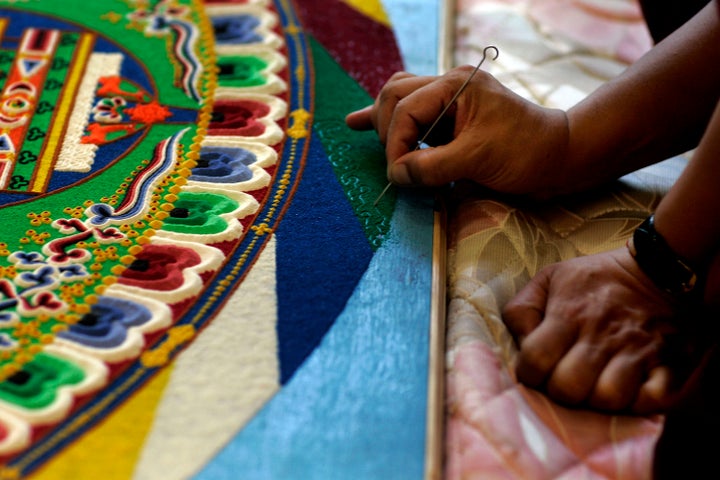
Editor's Note: Buddhist monks from Tibet who spend their lives going from place to place, from occasion to occasion, making sand mandalas, sacred cosmograms, that originated in India over 2,500 years ago, are coming to Gannon University in Erie, Pennsylvania this week. A few years ago, after witnessing the mandala process, Joan Chittister wrote a reflection for the National Catholic Reporter. This is an edited version.
The creation of a mandala, the representation of the world in divine form, perfectly balanced, precisely designed, is meant to reconsecrate the earth and heal its inhabitants. But it is more than a picture. Sand painting is an intricate process. It requires millions of pieces of sand to make a mandala five by five feet square. It requires a team of monks working anywhere from days to weeks, depending on the size of the mandala, to create this floor plan of the sacred mansion that is life. It requires the interplay of vivid colors and ancient symbols.
The monks bend over the piece for hours on end, dropping one grain of sand after another into intricate symbolic patterns. The purpose is to call the community to meditation and awareness of something larger than their own small world.
But the process itself, as laborious, as precise, as artistic, as stunningly powerful as it is, is not really the message.
When the mandala is finally finished, however long it takes for the monks to deal in this divine geometry of the heavens, they pray over it -- and then they destroy it. They sweep it up, every last grain of sand and give handfuls of it away to those who participate in the closing ceremony as a final memory of sublime possibility. Then they throw the rest of the sand into the nearest living stream to be swept into the ocean to bless the whole world. And that's it. It's gone. In an instant, after all that artistry, all that work, it's over.
They destroy it. Why? Because the underlying message of the mandala ceremony is that nothing is permanent. Nothing. All things are in flux, it says, beautiful but ephemeral, moving but temporary, a plateau but not a summit. All things are called to balance and enlightenment and the fulfillment of the Divine image in them, yes, but in flux. Always in flux.
There is nothing in the meaning of the mandala that denies or undermines the Christian story or its message, of course. But there is something shockingly profound to hear it coming from a wisdom written on the other side of the world. It gives a new note to an ancient truth. It strengthens the ties of humanity a world away.
Most of all, perhaps, it makes us all think again about what we think we're going to make permanent. Like our own domination of the world. Our privileged place in the community of nations. Our sense of status. Our surety of specialness among all the peoples of the world. Our place of comfort and security in the face of all the poor on the planet.
This Buddhist missionary message is clear.
Nothing is permanent, neither their state in life -- nor ours. The fact is that the politics of permanence is a sham. It has never lasted, and it never will. We may be seeing the dawn of that reality right now in the stock market, in oil prices, in jobs, in cost of living, in the national infrastructure.
From where I stand, it looks to me as if these monastics from another world may have as much a message for us as we ever did for everyone else. Hopefully we'll be as able to hear their message now as the rest of the world did ours and learn from others as they clearly have from us. Heaven knows, by anyone's geometry and symbols, we have mighty need for the "wisdom and compassion" they're trying to preserve.